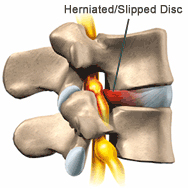6 Figtree Drive Sydney Olympic Park NSW 2127
Lumbar Disc Herniation
This condition is caused by wear and tear over time or due to sudden trauma. The disc does not slip as such but bulges like a weak point in a car tyre. Discs act as shock absorbers for the spine and have a central nucleus that provides cushioning and an outer fibrous ring for strength. If the outer fibres weaken then the nucleus pushes outwards.
Degenerative changes over time can cause weakness in the outer ring or the outer ring may be weakened by a sudden increase in load. The sudden trauma often involves bending forward and twisting whilst lifting light or heavy loads.
Signs and Symptoms
Pain can arise from the tearing of the outer ring and the bulging of the nucleus. It may also arise from the ‘bulge’ placing pressure on the central nervous system or other soft tissue structures. Compression of nerve tissue may result in referred pain into one or both legs. If pain occurs in the region of your ‘saddle’ then the bowel and bladder may be affected in which case urgent follow-up is necessary. Often sitting, prolonged standing and bending forward are aggravating activities with pain on sneezing and coughing.
Self Management
Avoidance of aggravating activities and attending to correct posture at all times is often essential. Heat or sometimes ice may be of assistance and sometimes painkillers are required. Keeping mobile within limits of pain is helpful but often a period of bed rest is required although finding position of comfort may be difficult.
How Treatment Can Help
Whilst any degenerative changes if present or the changes due to acute trauma cannot usually be reversed assessment and treatment may still be beneficial. Only in a small and rare number of cases is surgery the first choice of management or even required at all. A physiotherapist, massage therapist and sports doctor can assist by:
- Ordering scans (CT or MRI) to investigate the degree of degenerative or acute changes, bearing in mind that findings in scans are not always symptomatic i.e. a source of pain
- Prescribing medication if appropriate
- Teaching appropriate postural and strengthening exercises
- Relieving muscle tension by way of soft/deep tissue therapy and dry needling
- Mobilising joints in the thoracic and lumbar spine to ease the pressure of the herniated disc on other structures

View all our fact sheets
Sydney Sports Medicine Centre
Level 2, NSWIS Building
6 Figtree Drive
Sydney Olympic Park
NSW 2127
Written Correspondence
PO Box 3275
Rhodes NSW 2138
(02) 9764 3131 (02) 9764 3443
Appointments are available for some disciplines:
Mon - Fri
Saturdays
6:30am - 7:30pm
6:30am - 1:30pm
Reception is open:
Mon - Thurs
Fridays
Saturdays
8:00am - 7:00pm
8:00am - 6:00pm
8:00am - 1:00pm
